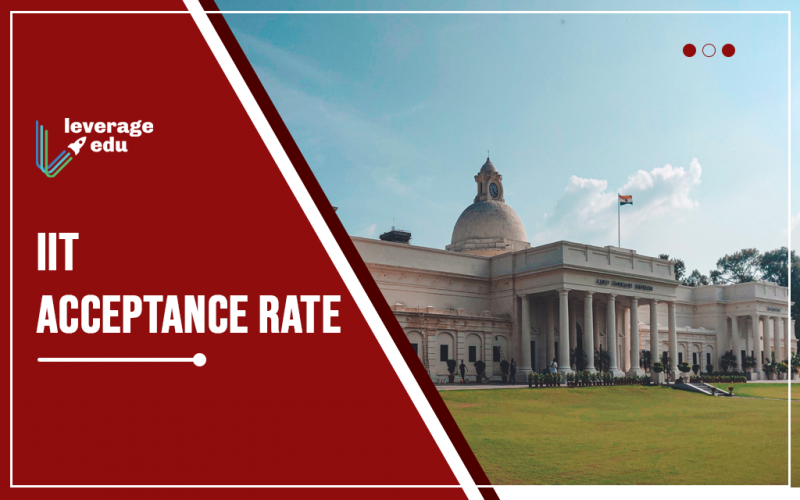IITs or the Indian Institutes of Technology are the oldest and most revered academic institutes in India. The first IIT was established in 1951. Since then, 23 IITs have been institutes of national importance for the advancement and excellence in areas like science, engineering and technology.
Consistently ranked at the top by NIRF India Ranking and Times Higher Education, these institutes offer technical programmes like bachelor, master and doctoral in a wide range of subjects. IITs are notoriously famous for being one of the toughest academic institutions because of the high competition and low acceptance rate. In this blog, we aim to familiarise you with the IIT acceptance rate, admission process and more!
Must Read: IIT vs MIT
This Blog Includes:
IIT Acceptance Rate For Undergraduate Courses
For the year 2020, around 8 lakh candidates registered for JEE Mains and about 6.35 lakh appeared for the exam. JEE Mains is conducted by the National Testing Agency across India but only the top 2. 50 lakh candidates are selected for JEE Advanced. This means that the IIT acceptance rate for undergraduate courses is 0.5%. Now, there are multiple factors behind a low acceptance rate in IITs: the syllabus structure is complex and demanding, the exam is highly competitive, attempts are limited and not to mention, the millions of people hankering for limited seats. The subsidised high-quality education, excellent placement records and the high calibre of research offered at IITs contribute to this low acceptance rate.
UG Courses: Admission Process
To understand the IIT acceptance rate, let us first look at the undergraduate process’s admission process. Indian Institutes of Technology offer undergraduate and integrated programmes in subject areas like engineering in various specialisations, architecture, sciences and design. IITs offer a total of 13,000+ seats for undergraduate programmes. The admissions to all these courses are conducted through the Joint Entrance Exam(JEE). Categorized as one of the toughest exams globally, JEE is the gateway to some of the most prestigious engineering colleges in India. Candidates seeking admissions at IITs must qualify JEE (Mains) to appear for JEE Advanced. After clearing these exams, selected candidates are invited for JoSAA counselling, wherein they are allotted seats in some of the best technical institutes.
Also Read: List of IIITs In India
UG Courses: Eligibility Criteria
Since clearing JEE is the prerequisite requirement for admissions, let us look at the eligibility criteria for this exam to understand the IIT acceptance rate better. They are mentioned below.
- Candidates who have passed the 10+ 2 exam level in the science stream with a minimum of 75% marks or will appear in the following year are eligible for the appearing.
- Candidates belonging to the general category must be born on or after October 1995 to be eligible.
- Candidates belonging to categories SC, ST or PwD have a relaxation of 5 years on the age limitation.
- There are no restrictions in terms of nationality; international students are eligible.
Do Read: Best Books For IIT JEE
IIT Acceptance Rate For Postgraduate Courses
When it comes to postgraduate engineering courses in IITs, the IIT acceptance rate varies tremendously from department to department. The seats offered at the postgraduate level are lesser while competition for GATE is high with over 8 lakh candidates appearing for the exam annually. GATE is only the primary step in the admission process; most engineering departments even hold written tests and personal interviews to select credible candidates for master programmes. For the year 2020, the estimated number of candidates that gave GATE were roughly over 6 lakh.
PG Courses: Admission Process
We now move forward to understand the IIT acceptance rate for postgraduate programs. Let’s begin by observing the admission process for the same. IITs offer several postgraduate programs in various engineering specialisations, sciences, architecture, management and design. Admissions to these courses are through different national entrances such as the Graduate Aptitude Test for Engineering (GATE) for engineering and architecture, CEED for design, IIT-JAM for M.Sc courses and CAT for MBA. These nationwide entrances may be followed by a written test or interview, depending upon the institution.
PG Courses: Eligibility Criteria
The eligibility criteria for each programme vary and the admission process is highly competitive and selective. This gives us a brief idea of the difficulty and approachability of the IIT acceptance rate. Listed here are the general eligibility criteria that you must meet:
- Candidates with a bachelor/master’s degree in the required course or equivalent programme from a recognised institution.
- Candidates must have scored a minimum of 60% in graduation level to be eligible.
- Candidates must fulfil specific requirements of the programme.
Must Read: MIT Acceptance Rate
FAQs
JEE is one of the toughest exams in India; this exam is the only way to access some of the best technical colleges India has to offer.
No, candidates must qualify for JEE Mains and then appear for JEE Advanced to seek admission to any IIT.
The admission process for IITs contains 3 main rounds; candidates must qualify for JEE Mains to appear for JEE Advanced. After the ranks for JEE Advanced are announced selected candidates are invited for JoSAA counselling and allotted seats based on stream preference and seat availability.
Hopefully, this blog on the IIT acceptance rate was insightful and educational for you! IITs are extremely tough to get into because of a plethora of reasons but it is not impossible.
IITs have an impressive alumni network spread across the world and you could be one of them if you work hard and stay focused. If you are confused about your career path and need some expert guidance then contact Leverage Edu and book a session today!

 One app for all your study abroad needs
One app for all your study abroad needs





















 45,000+ students realised their study abroad dream with us. Take the first step today.
45,000+ students realised their study abroad dream with us. Take the first step today.

